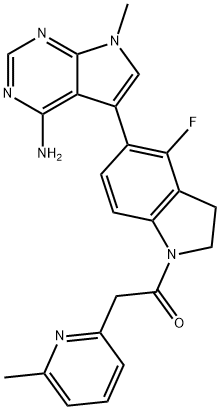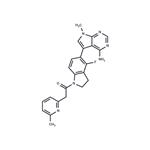Description
GSK2656157 (1337532-29-2) is a potent (IC50 = 0.9 nM) and selective (over 300 kinases) inhibitor of protein kinase RNA-like endoplasmic reticulum kinase (PERK).1,2? Inhibited growth of multiple human tumor xenografts in mice. GSK2656157 has also been found to potently inhibit RIPK1 (IC50 = 69 nM) and TNF-mediated RIPK1 kinase-dependent cell death in mouse embryonic fibroblasts.3 It prevented the loss of dendritic spines and rescued memory deficits after traumatic brain injury.4? GSK2656157 also enhanced glucose-stimulated insulin secretion in a mouse model of type 2 diabetes mellitus.5
Uses
GSK2656157 is an ATP-competitive and highly selective inhibitor of PKR-like endoplasmic reticulum kinase (PERK) enzyme activity. GSK2656157 also has anti-tumor and anti-angiogenic activity.
Definition
ChEBI: GSK2656157 is a pyrrolopyrimidine that is 7-methyl-7H-pyrrolo[2,3-d]pyrimidin-4-amine which has been substituted at position 5 by a 4-fluoro-2,3-dihydro-1H-indol-5-yl group, the nitrogen of which has been acylated by a (6-methylpyridin-2-yl)acetyl group. An orally bioavailable PERK inhibitor. It has a role as an EC 3.1.3.48 (protein-tyrosine-phosphatase) inhibitor, a PERK inhibitor and an antineoplastic agent. It is a pyrrolopyrimidine, a biaryl, a member of indoles, a member of methylpyridines, an organofluorine compound and a tertiary carboxamide.
in vivo
assay shows that a single 50 mg/kg oral dose of gsk2656157 can completely inhibit the thr980 phosphorylation of endogenous pancreatic perk in mice. furthermore, gsk2656157 causes dose-dependent inhibition of tumor growth in human tumor xenograft models of pancreatic cancer (bxpc3, hpac and capan2) and multiple myeloma (nci-h929). among these cancers, the capan2 tumor is most sensitive [1].
References
Atkins et al. (2013) Characterization of a novel PERK kinase inhibitor with antitumor and antiangiogenic activity; Cancer Res. 73 1993
Axten et al. (2014) Discovery of GSK2656157: An Optimized PERK Inhibitor Selected for Preclinical Development; ACS Med. Chem. Lett. 4 964
Rojas-Rivera et al. (2017) When PERK inhibitors turn out to be new potent RIPK1 inhibitors: critical issues on the specificity and use of GSK2606414 and GSK2656157; Cell Death Differ. 24 1100
Sen et al. (2017) Activation of PERK Elicits Memory Impairment through Inactivation of CREB and Downregulation of PSD95 After Traumatic Brain Injury; Neurosci. 37 5900
Kim et al. (2019) Specific PERK inhibitors enhanced glucose-stimulated insulin secretion in a mouse model of type 2 diabetes; Metabolism, 97 87



